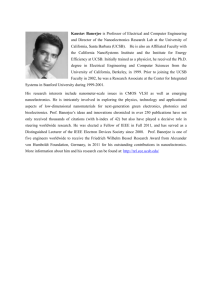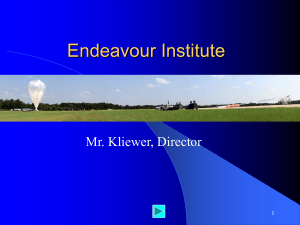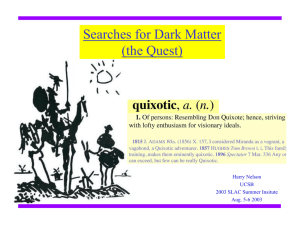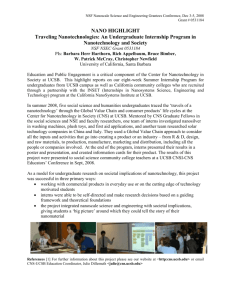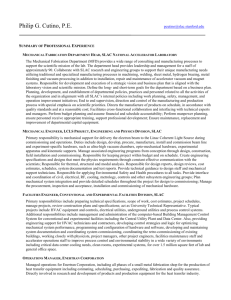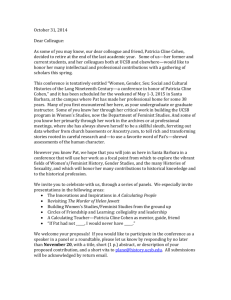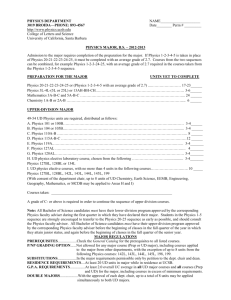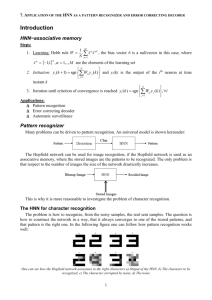Searches for Dark Matter (the Quest)
advertisement
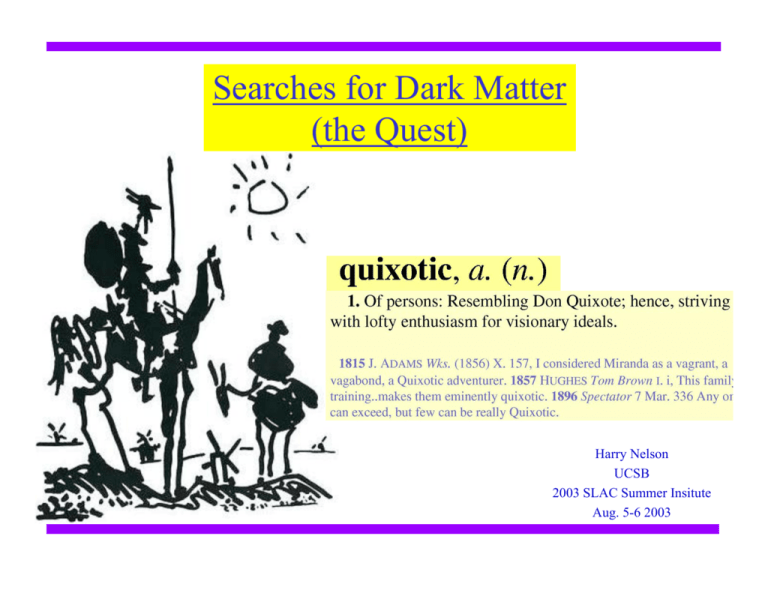
Searches for Dark Matter (the Quest) Harry Nelson UCSB 2003 SLAC Summer Insitute Aug. 5-6 2003 HNN z z z UCSB Plan Introductory Material Axions Massive Particles ⟩ Direct Detection Strongly Interacting → Weakly Interacting → ⟩ z Indirect Detection Concluding Material Small calculations, supporting material interspersed… my goal is to develop a `feel’ 8/5/03 SLAC Summer Institute 2 HNN z Some Sources… UCSB M. Srednicki, 1994 SLAC Summer Institute http://www.slac.stanford.edu/pubs/confproc/ssi94/ssi94-010.html z M. Perl et al., 2001 http://www.slac.stanford.edu/pubs/slacpubs/8000/slac-pub-8772.html z z z IDM 2002 http://www.shef.ac.uk/~phys/idm2002/talks/ SPIRES http://www.slac.stanford.edu/spires/hep/ NASA Astrophysics Data System http://adswww.harvard.edu/index.html Apologies for figures not perfectly acknowledged… Thanks to many colleagues… particularly Ron Ross… 8/5/03 SLAC Summer Institute 3 HNN UCSB The Milky Way’s Dark Halo (?) R is the distance from center v v is the speed (tangential) Honma and Sofue, 1996 R v 220 km/s Without the Dark Halo ∆:v0=180 km/s (Binney & Tremaine) ⊕ 8/5/03 SLAC Summer Institute R 4 HNN UCSB The Dark Ball Bulge Disk Dark Matter `Halo’ Why haven’t dark matter `particles’ fall into our disk? • Dark particles scarcely interact with us and/or • Dark particles very heavy (150 passes/age of U)×(0.3 to 2) × 10-2 gm/cm2 ∼ (0.5 to 3) gm/cm2 … not very restrictive 8/5/03 SLAC Summer Institute 5 HNN UCSB Theoretical Guidance… Caveat Emptor 8/5/03 SLAC Summer Institute 6 HNN 8/5/03 Remainder of L. Alvarez Essay SLAC Summer Institute UCSB 7 HNN Talavera … reviewed Columbus UCSB 12,000 km (Talavera, accurate) 5,000 km (Columbus, fudged systematics) Japan (Cipangu) Both simplified the intervening region to pure ocean Portugal/Spain Oversimplification! 8/5/03 SLAC Summer Institute 8 HNN Usual Simplifications of Dark Matter z UCSB Local energy density, speed of DM km MeV ú 0 ø 300 v 0 ø 220 (ì 0 ø 7 â 10 à4) 3 s cm (ì 20 12 10 6) 0? (200-2000) (170-270) … from galactic astrophysics z Consists of one elementary particle (!) γ , νe,µ,τ , e- , p , n - 7 in our few percent of Univ. 2 are composite… n ?? The DM particle that provides the clearest signal in a search might not be the most abundant – a strong argument for an eclectic mix of search techniques. 8/5/03 SLAC Summer Institute 9 HNN Advice of Dennis the Menace 8/5/03 SLAC Summer Institute UCSB 10 HNN Usual Simplifications of Dark Matter z z UCSB DM not baryons (CBR, BBN; Eros/MACHO) DM was once in thermal equibrium mass > few keV (large scale structure) mass < 340 TeV (unitarity) cross section with us ≈ weak (10-44-10-36 cm2)… little unknown missing energy at LEP, Tevatron… mass>10’s GeV Weakly Interacting Massive Particles SUSY restored just above weak scale gives WIMPS …Attractive candidates (axions, `*zillas’, etc.) were never in thermal equilibrium… z DM at rest: 8/5/03 ⟨vDM⟩=0 (sun plowing through at v0 ≈ 220 km/s) 2 ⟩1/2 ≈ 300 km/s… useful to approximate ≈ 0 ⟨vDM SLAC Summer Institute 11 HNN z UCSB Scope Keep an open mind… γ νe,µ,τ e- π0 p n -- Our Matter Imagine arbitrary (short distance) interaction, mass SIMP, *zilla χ0 (SUSY, neutralino, WIMP) Assume >10’s GeV X±ε a 8/5/03 (experimental technique) `milli’ -CHAMP axion, couples to γγ… nonthermal, very light SLAC Summer Institute 12 HNN z UCSB Direct Detection Momentum Transfer v0 Convert a to photon – detect it axion m v0 target Massive Particle Cause target recoil – detect it 8/5/03 SLAC Summer Institute 13 HNN UCSB Axions (and similar) axion models (Dark matter) 1.9-3.4 µeV (ADMX, LLNL-Florida-Berkeley-NRAO) 8/5/03 SLAC Summer Institute 14 HNN UCSB Primakoff Conversion, Microwave Detection Amplifier – power pours out of cavity when B0 applied Solenoid LB= 50 cm Cavity, `TM’ mode (E parallel to B0: 0- ) 8/5/03 SLAC Summer Institute 15 HNN UCSB Tunable Cavity Tuning Rods 2×Q× 80 sec/scan ≈ 1 year 8/5/03 SLAC Summer Institute 16 UCSB Signal Level and Noise 10-17 W from Pioneer 10 Spacecraft, 1010 km away ∝(s/n) HNN HEMT 10-26 W → ∝(time) Substantial improvements in Ts are on the horizon (X30) from increased cooling, SQUIDS 8/5/03 SLAC Summer Institute 17 HNN UCSB Example of Data, Expected Signal Long resident axions Axions just streamed in from galactic periphery (≈β2 ) 8/5/03 SLAC Summer Institute 18 HNN µeV Axion Future UCSB • ADMX – SQUIDs, hope to cover 2 decades in mass • Kyoto – single quantum detector 8/5/03 SLAC Summer Institute 19 HNN CAST – Axions from the Sun UCSB cm2 sec1 keV 1 8 × 1014 6 × 1014 4 × 1014 2 × 1014 0 0 2 LHC Dipole y ra tor X ec t de 8/5/03 ay r X 4 T ns a r r ve E (keV) se 6 8 ti e gn a m B) ( ld e i cf 10 s n io x a L SLAC Summer Institute 20 HNN Experiment and Expected Sensitivity UCSB SOLAX + COSME Helium to suppress momentum transfer 8/5/03 SLAC Summer Institute 21 HNN UCSB Massive Particles: Recoil Kinematics - I 2/3 8/5/03 SLAC Summer Institute 22 HNN Recoil Kinematics - II 8/5/03 SLAC Summer Institute UCSB 23 HNN UCSB Nuclear Recoil – Cross Section ∝A4 8/5/03 SLAC Summer Institute 24 HNN Nuclear Recoil – Diffraction UCSB Iodine (A=127) DAMA 0 110 220 330 keV ER 8/5/03 SLAC Summer Institute 25 HNN UCSB Nuclear Recoils from Massive Dark Matter z Deposit 10’s of keV ⟩ z z z Mechanism of deposition after recoil (dE/dx) very similar to how charged dark matter would deposit energy directly For target atomic weight A<160, dark matter velocity spectrum a delta-function, recoil spectrum flat up to an endpoint Diffraction off nucleus, form factor of nucleus directly appear in recoil spectrum Cross section favorable as A increases ⟩ Haven’t focused on magnitude of cross section yet… →10-44-10-36 8/5/03 cm2 (weak) or 10-24 cm2 (strong) still fine… SLAC Summer Institute 26 HNN To Penetrate the Atmosphere 8/5/03 SLAC Summer Institute UCSB 27 HNN SIMP exclusion (above/below atmos.) UCSB Penetrate to Earth Wandelt et al., astro-ph/0006344 8/5/03 WIMPS SLAC Summer Institute Baudis & Albuquerque, astro-ph/0301188 28 HNN UCSB Guide to Exclusion Plots T≥ excluded <1 particle penetrates excluded: ≥ 8/5/03 SLAC Summer Institute 29 HNN WIMP/nucleon σ≈10-42 cm2 UCSB Exper. CDMS DAMA Theory SUSY, various constraints including Big Bang 8/5/03 SLAC Summer Institute 30 HNN UCSB Compare with Common Background Rate ≡ DRU • Shield (shield radioactive too!)… 1 ev/(kg d keV) typical • Reduce the background… HDMS , IGEX , Genius • Exploit astron. properties (year cycle, directionality) DAMA, DRIFT • Devise detectors that can distinguish nuclear recoil from electron recoil… Edelweiss, CDMS, Xenon.. 8/5/03 SLAC Summer Institute 31 HNN Germanium: Quest for Lowest Background UCSB HDMS at Gran Sasso (3800 mwe (meters water equivalent) depth) Inner Germanium (0.2 kg) Outer Ge (2.1 kg) Spectrum of Inner Ge, 132.4 days Red: No Hit in Outer Ge 0.3 DRU 8/5/03 SLAC Summer Institute 32 HNN UCSB IGEX (2 kg Ge, CANFRANC, 2450 mwe) 1.0 BACKGROUND 4-10 keV background: 10-20 keV background: 25-40 keV background: 0.9 counts/keV/kg/day 0.8 0.7 0.22 c/keV/kg/day 0.10 c/keV/kg/day 0.04 c/keV/kg/day 0.6 Previous spectrum (236 kg-days) 0.5 IGEX-DM data since summer 2001 (194 kg-days) Neutron shielding improved 0.4 0.3 Further increased neutron shielding (82 kg-days) 0.2 0.1 0.0 0 10 20 30 40 50 Energy (keV) 8/5/03 SLAC Summer Institute 33 HNN UCSB KeVee versus KeV (Recoil); Signal Shape 1.0 Only about 1/3 of energy of a nu recoil appears in Ge as ionization E. Simon et al., 2003 0.9 counts/keV/kg/day 0.8 0.7 0.6 0.5 0.4 0.3 0.2 0.1 0.0 0 0 IGEX 8/5/03 3010 30 40 6020 90 120 Energy (keV) KeV Recoil Energy (KeV) ee SLAC Summer Institute 50 150 34 HNN UCSB IGEX Exclusion Region 10-39 IGEX-DM 2000 IGEX-DM 2001& 2002 -40 σp (cm2) 10 -41 10 DAMA allowed -42 10 1 8/5/03 5 10 50 100 m (GeV) SLAC Summer Institute 5001000 35 HNN Genius Program – Background Elimination UCSB Suspend Ge detector in Liquid Nitrogen L= 2 m 0.1 events/(kg KeV d) Genius Test Facility (under construction) 40 kg Ge 8/5/03 Baudis et al., 2001 SLAC Summer Institute 36 HNN Ultimate Genius 8/5/03 SLAC Summer Institute UCSB 37
